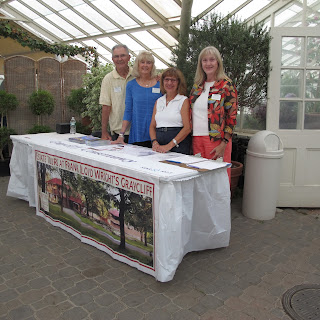Careful! Warning! DO NOT TOUCH!
This just in from John Strawbrich, Graycliff's extremely helpful maintenance/preservationist:
There are centipedes at Graycliff that look really cute...but are highly poisonous. DO NOT TOUCH them. You'll end up with a painful rash.
Hickory tussock moth caterpillar:
Just opened at the Burchfield Penney Art Center:
A fascinating exhibition on Buffalo's first African American architect, John Brent. Saw it myself this past weekend, and it's a must-see for anyone interested in Buffalo history and/or architecture. Absolutely fascinating!
THROUGH THESE GATES: BUFFALO’S FIRST AFRICAN AMERICAN ARCHITECT, JOHN E. BRENT
On View Friday, October 9, 2015–Sunday, March 27, 2016
Recent research has uncovered significant contributions to architectural and landscape design made by John Edmonston Brent (1889-1962) in the city of Buffalo and surrounding counties of Western New York. His grandfather, John Edmondson Brent, was born a slave, but later purchased his freedom and that of his wife. His father, Calvin Thomas Stowe Brent, was an accomplished architect in Washington, DC, “one of the most sophisticated cities of Black culture,” according to architect Robert Traynham Coles, who wrote a biographical sketch about John E. Brent for the book African-American Architects: A Biographical Dictionary, 1865-1945, published in 2004.
Named after his grandfather, Brent was born in the nation's capitol, educated at the Tuskegee Institute, and received a full scholarship at the Drexel Institute of Art, Science and Industry, graduating in 1912. He came immediately to Buffalo, N.Y. and started employment with Max G. Beirel, thus becoming the first African American architect in the city. He was a member of the American Institute of Architects. In addition to his architectural engineering and design accomplishments, Brent became the first president of the Buffalo Branch of the National Association for the Advancement of Colored People (N.A.A.C.P.) on November 30, 1914.
Between 1912 and 1926, Brent worked with several architectural firms, including Henry Osgood Holland; Waterbury & Mann; Julius C. Schultz; North and Shelgren, and Oakley & Schallmore. In 1926, he opened his own home office at 99 Lonsdale Avenue in Hamlin Park in Buffalo and managed many private commissions.
Among Brent’s most significant architectural designs is the Michigan Avenue Branch Y.M.C.A. (1928), his first large commission. It was initially funded a gift of $25,000 by Julius Rosenwald, who was the founder of Sears & Roebuck in Chicago and patron of African American schools in the South. Subsequent funders included Mrs. Anna McDougall, who started a capital campaign endowment, and Mr. and Mrs. George B. Mathews, whose magnanimous endowment gift of $100,000 was known as the Booker T. Washington Foundation. Brent was the second African American in the United States to design a building for the Young Men’s Christian Association. (Eight of his architectural drawings for the project were exhibited at the Howard University Art Gallery in 1931 in an exhibition of the work of Negro Architects presented by the Department of Architecture.) The building was demolished in 1977.
From 1931 to 1934 Brent worked for the U. S. Department of the Interior as a draftsman for the Founders Library and other buildings at Howard University in Washington, DC. From the Great Depression through the 1950s, the Buffalo Parks Department employed him, and documents show his involvement with the designs of Front Park, the Buffalo Zoological Gardens, and other public spaces with landscape architect Roeder J. Kinkel.
In 1958, Brent was recognized as “Man of the Year” by the editor and publishers of the Negro Directory of the Niagara Frontier. (The "Woman of the Year” was Mrs. Cora P. Maloney, the first woman in the city of Buffalo to become Councilman for the Masten District. They both were lauded as “Outstanding Citizens of the Community” and pictured on the cover of the publication.)
Brent posthumously received recognition in Buffalo for design of Gates #3 and #4 for the Buffalo Zoological Gardens. The 8-ft. high cast iron gates that were produced in 1935 are anchored in concrete piers with Onondaga limestone veneers to provide welcoming entrances to earlier zoo paths. The structures were listed on the National Register of Historic Places in 2013. Brent continued working on drawings for zoo structures and grounds for the next two decades, which will be illustrated in the exhibition. Through his own practive, he also designed private and public buildings, including:
Mitchell Miles Residence, 4550 Genesee Street, Cheektowaga, NY, 1928 [Mitchell Miles was the brother of Marshall Miles, the manager of champion U.S. heavyweight boxer Joe Louis.]
3 Summer Cottages for Cora C. Cohen, Clara L. Payne, and himself, Center Road, Wales, NY, 1937 [Cora C. Cohen owned the 15 acres of land; Clara L. Payne was the first African American social worker]
Myron McGuire, DDS Medical Office, 482 Jefferson Avenue, Buffalo, NY, c. 1930s
Wales Hollow Camp, Center Road, Wales, NY, 1934
New Building for Cold Spring Baptist Church, 185 Verplanck Street/254 Woodlawn Avenue, Buffalo, NY (1955)
Appomattox Club House, Eagle Street, Bertie, Ontario, Canada, 1956
The exhibition will illustrate John E. Brent’s architectural and landscape designs through vintage and contemporary documentary photographs as well as original drawings, blueprints and true-scale copies. Artifacts enhancing the display include drafting tools from Brent’s home office, vintage documents from the N.A.A.C.P., and materials relating to the Michigan Avenue Branch Y.M.C.A. from the University Archives, State University of New York at Buffalo. In addition, facsimile Buffalo Zoo gates have been produced by artists Patrick Robideau and Chris Siano. Brent’s legacy will be illustrated with information about other African American architects in Western New York, including Robert Traynham Coles, Edward O. Watts and Anne N. Perry.





































